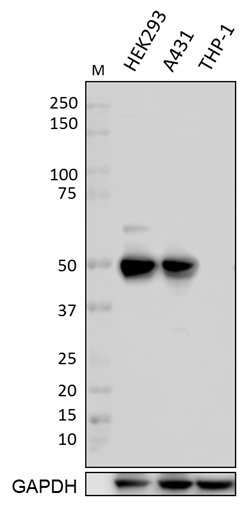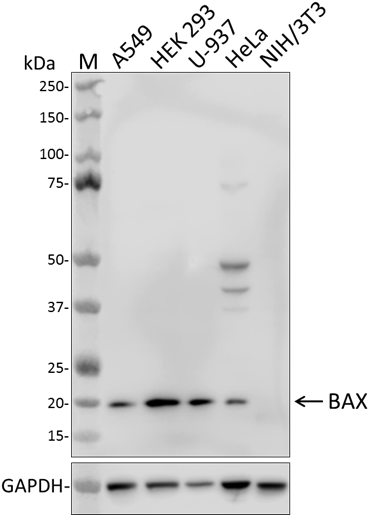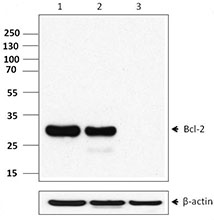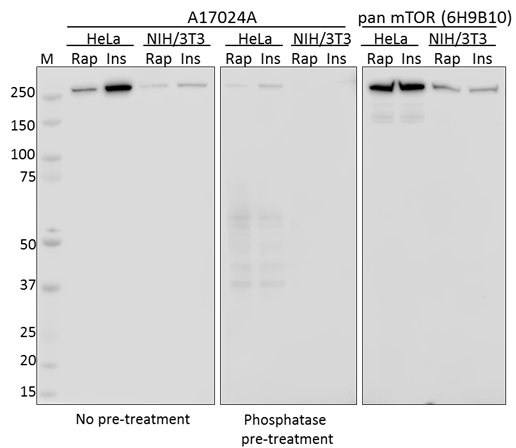- Clone
- 6H9B10 (See other available formats)
- Regulatory Status
- RUO
- Other Names
- FKBP12-rapamycin complex-associated protein 1, FK506 binding protein 12-rapamycin associated protein 1, FRAP1
- Isotype
- Mouse IgG1, κ
- Ave. Rating
- Submit a Review
- Product Citations
- publications

-

Whole cell extracts (15 µg protein) from the indicated cell lines were resolved on a 4-12% Bis-Tris gel, transferred to PVDF and probed with 1.0 µg/mL (1:500 dilution) of Purified anti-mTOR Antibody, clone 6H9B10, overnight at 4°C. Proteins were visualized by chemiluminescence detection using HRP goat anti-mouse IgG antibody (Cat. No. 405306) at a 1:3000 dilution. Direct-Blot™ HRP anti-GAPDH Antibody (Cat. No. 607904) was used as a loading control at a 1:25000 dilution (lower). Lane M: Molecular Weight marker. Lysates were loaded in order of descending mTOR expression (Source: Human Protein Atals).
| Cat # | Size | Price | Quantity Check Availability | Save | ||
|---|---|---|---|---|---|---|
| 659201 | 25 µg | 72€ | ||||
| 659202 | 100 µg | 193€ | ||||
mTOR (mammalian target of rapamycin) is a 289 kD member of the PI3 kinase family, containing HEAT, FRB, and FATC domains. mTOR is expressed in the nucleus and cytoplasm, and is a target for cell-cycle arrest and the immunosuppressive effects of FKBP12-rapamycin complex. mTOR controls ribosome biogenesis and cell growth, and acts as an ATP sensor. mTOR is repressed by nutrient deprivation and mitochondrial uncoupling. mTOR is the target of PI3K-regulated protein kinase, AKT/PKB (phosphorylated at Thr 2446 and Ser2448). mTOR has also been shown to bind RAPTOR, which negatively regulates mTOR kinase activity, and is also inhibited by tuberin-hamartin tumor suppressor complex. The binding of RAPTOR to mTOR is necessary for the mTOR-catalyzed phosphorylation of 4EBP1 in vitro, and it strongly enhances the mTOR kinase activity toward p70-alpha.
Product DetailsProduct Details
- Verified Reactivity
- Human, Mouse
- Antibody Type
- Monoclonal
- Host Species
- Mouse
- Immunogen
- Partial human mTOR recombinant protein (1186-1385 aa) expressed in E. coli.
- Formulation
- This antibody is provided in phosphate-buffered solution, pH 7.2, containing 0.09% sodium azide.
- Preparation
- The antibody was purified by affinity chromatography.
- Concentration
- 0.5 mg/ml
- Storage & Handling
- The antibody solution should be stored undiluted between 2°C and 8°C.
- Application
-
WB - Quality tested
- Recommended Usage
-
Each lot of this antibody is quality control tested by Western blotting. For Western blotting, the suggested use of this reagent is 0.25 - 1.0 µg per ml. It is recommended that the reagent be titrated for optimal performance for each application.
- Product Citations
-
- RRID
-
AB_2563155 (BioLegend Cat. No. 659201)
AB_2563156 (BioLegend Cat. No. 659202)
Antigen Details
- Structure
- 2549 amino acids encode a protein with predicted MW of 289 kD.
- Distribution
-
Nucleus, Cytoplasm
- Function
- The protein encoded by this gene belongs to a family of phosphatidylinositol kinase-related kinases. These kinases mediate cellular responses to stresses such as DNA damage and nutrient deprivation. This protein acts as the target for cell-cycle arrest and immunosuppressive effects of the FKBP12-rapamycin complex.
- Interaction
- Part of the mammalian target of rapamycin complex 1 (mTORC1) which contains MTOR, MLST8, RPTOR, AKT1S1/PRAS40, and DEPTOR; also part of the mammalian target of rapamycin complex 2 (mTORC2) which contains MTOR, MLST8, PRR5, RICTOR, MAPKAP1, and DEPTOR.
- Biology Area
- Cell Biology, Cell Cycle/DNA Replication, Signal Transduction
- Antigen References
-
1. Brown EJ, et al. 1994. Nature. 369:756.
2. Dennis P, et al. 2001. Science. 294:1102.
3. Fingar D, et al. 2002. Genes Dev. 16:1472.
4. Nojima H, et al. 2003. J. Biol. Chem. 278:15461. - Gene ID
- 2475 View all products for this Gene ID
- UniProt
- View information about mTOR on UniProt.org
Other Formats
View All mTOR Reagents Request Custom Conjugation| Description | Clone | Applications |
|---|---|---|
| Purified anti-mTOR | 6H9B10 | WB |
Customers Also Purchased



Compare Data Across All Formats
This data display is provided for general comparisons between formats.
Your actual data may vary due to variations in samples, target cells, instruments and their settings, staining conditions, and other factors.
If you need assistance with selecting the best format contact our expert technical support team.
-
Purified anti-mTOR

Whole cell extracts (15 µg protein) from the indicated cell ...
 Login / Register
Login / Register 








Follow Us